TriSimple
TriMultiCrit
TriPerso
SousTot
Fonction Sous.Total()
Tri VBA
Tri 2 Critères
Tri lignes & colonnes
Tri Zones Vides
Tri numérique de valeurs alphanumériques
Tri dynamique
Tri par groupe
Tri de fiches
Tri colonnes
Tri Gras
Tri sur la couleur de fond
Tri cadres
Tri avec images
Tri par clic sur le titre
Tri mots avec apostrophes
Tri multi-feuilles
Tri des onglets
Tri quick-sort
Tri matriciel
Fonction liste triée
Liste triée Multi-Zones
Tri de multiples blocs
Fonction Tri & Filtre
Tri simple
- Cliquer dans la colonne de tri (B2 pour trier par service)
- Icône A-Z
Tri multi-critères
- Cliquer dans la base (A1 par exemple)
- Données/Trier
Tri personnalisé
On veut trier par service dans l'ordre DG,Etudes,Marketing,Ventes,Fabric:
- Créer une liste personalisée (DG,Etudes,Marketing,Ventes,Fabric) avec la commande Outils/Options/Liste perso
- Cliquer dans la base
- Données/Trier
- Choisir Service
- Options
- Choisir la liste personnalisée
Création liste personnalisée
Options de tri
Sous totaux
On veut obtenir la moyenne des salaires par service.
- Trier par service
- Données/sous-total
Fonction Sous.Total(NoFonction;champ1;Champ2, ..)
Donne un total dans une liste filtrée.
| No Fonction |
Lignes masquées |
Opération |
| 1 |
101 |
MOYENNE |
| 2 |
102 |
NB |
| 3 |
103 |
NBVAL |
| 4 |
104 |
MAX |
| 5 |
105 |
MIN |
| 6 |
106 |
PRODUIT |
| 7 |
107 |
ECARTYPE |
| 8 |
108 |
ECARTYPEP |
| 9 |
109 |
SOMME |
| 10 |
110 |
VAR |
Sur cet exemple, nous calculons des sous-totaux par poste et un total général.
Tri en VBA
champ.Sort Key1:=cellule, Order1:=xlAscending/XlDescending,
Key2:=cellule, Order2:=xlAscending/XlDescending,
Key3:=cellule, Order3:=xlAscending/XlDescending,
Header:=xlGuess
Tri 1 critère
Sub tri()
Sheets("BD").[A1].Sort key1:=Sheets("BD").[A2],
Order1:=xlAscending, Header:=xlGuess
End Sub
Tri 2 critères
Sub tri2()
Sheets("BD2").[A1].Sort key1:=Sheets("BD2").[A2],
Order1:=xlAscending, _
key2:=Sheets("BD2").[B2],
Order2:=xlAscending, Header:=xlGuess
End Sub
Tri lignes & colonnes d'un tableau 2D
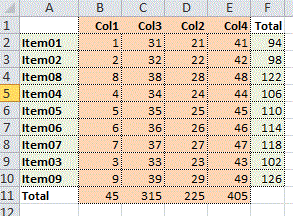
Sub TriLigCol()
Set Adr = Range("A1")
Nlignes = Adr.CurrentRegion.Rows.Count - 1
Ncols = Adr.CurrentRegion.Columns.Count - 1
'--- tri lignes & colonnes
Set Rng = Adr.Resize(Nlignes, Ncols)
Rng.Offset(1).Resize(Rng.Rows.Count - 1, Rng.Columns.Count).Sort
key1:=Rng.Cells(2, 1), _
Order1:=xlAscending, Header:=xlNo, MatchCase:=False,
Orientation:=xlSortColumns
Rng.Offset(, 1).Resize(Rng.Rows.Count, Rng.Columns.Count -
1).Sort key1:=Rng.Cells(1, 2), _
Order1:=xlAscending, Header:=xlNo, MatchCase:=False,
Orientation:=xlSortRows
End Sub
Tri vertical
Tri horizontal d'une ligne
Sub Tri()
For i = 0 To 4
Set Rng = Range("B6:F6").Offset(i)
Rng.Sort key1:=Rng.Cells(1, 1), Order1:=xlAscending,
Header:=xlNo, MatchCase:=False, Orientation:=xlSortRows
Next i
End Sub
Tri avec zones incomplétes
On veut trier par département.
Sub Tri()
Set début = Range("A1")
ncol = début.CurrentRegion.Columns.Count
début.Offset(0, ncol).EntireColumn.Insert Shift:=xlToRight
Set rng1 = début.CurrentRegion.Resize(, 1)
Set Rng2 = début.CurrentRegion.Offset(0, ncol).Resize(,
1)
Rng2.Value = rng1.Value
Rng2.SpecialCells(xlCellTypeBlanks).FormulaR1C1 = "=R[-1]C"
Rng2.Value = Rng2.Value
début.Sort Key1:=Cells(1, ncol + 1), Order1:=xlAscending,
_
Header:=xlGuess
Cells(1, ncol + 1).EntireColumn.Delete
End Sub
Tri
-Italic en second
-Gras en troisième
-Barré en 4e
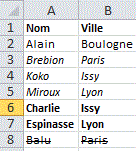
Sub TriCol()
Columns("B:B").Insert Shift:=xlToRight
For i = 2 To [a65000].End(xlUp).Row
Cells(i, 2) = 1
If Cells(i, 1).Font.Bold Then Cells(i, 2) = 3
If Cells(i, 1).Font.Italic Then Cells(i, 2) =
2
If Cells(i, 1).Font.Strikethrough Then Cells(i,
2) = 4
Next
[A2].CurrentRegion.Sort Key1:=[B2], Order1:=xlAscending,
Header:=xlYes
[B:B].Delete Shift:=xlToLeft
End Sub
Conserve le focus après tri
Sub TriNom()
nom = Cells(ActiveCell.Row, 1)
col = ActiveCell.Column
[A2:C1000].Sort key1:=[A2]
On Error Resume Next
[a:a].Find(what:=nom).Offset(, col - 1).Select
End Sub
Tri dans l'ordre numérique de valeurs alphanumériques
Tri Numérique
Tri suivant Numérique
Tri Alpha après
Numérique
Tri AlphaNumSansDoublons
Sub triColInter2()
[b:b].Insert
For Each c In Range([A2], [a65000].End(xlUp))
c.Offset(0, 1) = Val(c)
Next c
Range("A2").CurrentRegion.Select
Selection.Offset(1).Resize(Selection.Rows.Count - 1).Select
Selection.Sort Key1:=[B2]
[b:b].Delete
End Sub
Tri AlphaNum Plusieurs séquences
Choix de la colonne de tri dans une liste
Private Sub Worksheet_Change(ByVal Target As Range)
If Target.Address = "$G$2" And Target.Count
= 1 Then
col = Application.Match(Target, [A1:D1],
0) - 1
Range("A2:D30").Sort Key1:=[A1].Offset(0,
col)
End If
End Sub
Tri dynamique
Le tri est effectué à chaque saisie d'un nom
Private Sub Worksheet_Change(ByVal Target As Range)
If Target.Column = 1 And Target.Count = 1 Then
m = Target
[A2:C1000].Sort Key1:=[A2]
[A:A].Find(What:=m, LookIn:=xlValues).Select
End If
End Sub
Tri par groupe
Sub TriCol()
Columns("B:B").Insert Shift:=xlToRight
i = 1
Do While i <= [a65000].End(xlUp).Row
temp = Cells(i, 1)
Cells(i, 2) = temp
i = i + 1
Do While Not Left(Cells(i, 1), 1) = "["
And i <= [a65000].End(xlUp).Row
Cells(i, 1).Offset(0, 1) = temp &
Cells(i, 1)
i = i + 1
Loop
Loop
[A1].CurrentRegion.Sort Key1:=[B2], Order1:=xlAscending, Header:=xlNo
[B:B].Delete Shift:=xlToLeft
End Sub
Tri les Blocs
Les blocs sont repérés par une couleur. Il n'y a pas de quadrillage.
Sub Tri()
nbCol = [A1].CurrentRegion.Columns.Count
couleurPremier = [A1].Interior.ColorIndex
Columns("A:A").Offset(0, nbCol).Insert Shift:=xlToRight
i = 1
Do While i <= [a65000].End(xlUp).Row
temp = Cells(i, 1)
Cells(i, 1).Offset(0, nbCol) = temp
i = i + 1
Do While Cells(i, 1).Interior.ColorIndex <>
couleurPremier And i <= [a65000].End(xlUp).Row
Cells(i, 1).Offset(0, nbCol) = temp
i = i + 1
Loop
Loop
[A1].CurrentRegion.Sort Key1:=Range("A1").Offset(0,
nbCol), Order1:=xlAscending, Header:=xlNo
[A:A].Offset(0, nbCol).Delete Shift:=xlToLeft
End Sub
Tri suivant les titres en gras
Sub TriCol()
Columns("B:B").Insert Shift:=xlToRight
i = 1
Do While i <= [a65000].End(xlUp).Row
temp = Cells(i, 1)
Cells(i, 2) = temp
i = i + 1
Do While Not Cells(i, 1).Font.Bold And i <=
[a65000].End(xlUp).Row
Cells(i, 1).Offset(0, 1) = temp
& Cells(i, 1)
i = i + 1
Loop
Loop
[A1].CurrentRegion.Sort Key1:=[B2], Order1:=xlAscending, Header:=xlNo
[B:B].Delete Shift:=xlToLeft
End Sub
Tri de fiches
Tri Fiches
Tri Fiches2
Tri Fiches Colonne
Sub Tri(LigneDébut, HauteurBloc, numCol, ordre, DecalTri)
nbcol = Cells(LigneDébut, 1).CurrentRegion.Columns.Count
Columns("A:A").Offset(0, nbcol).Insert Shift:=xlToRight
i = LigneDébut
Do While i <= [a65000].End(xlUp).Row
Cells(i, nbcol + 1).Resize(HauteurBloc, 1) = Cells(i
+ DecalTri, numCol)
i = i + HauteurBloc
Loop
derLig = Cells(65000, nbcol + 1).End(xlUp).Row
Range(Cells(LigneDébut, 1), Cells(derLig, nbcol + 1)).Sort
_
Key1:=Cells(LigneDébut + 1, 1).Offset(0,
nbcol), Order1:=ordre, Header:=xlNo
[A:A].Offset(0, nbcol).Delete Shift:=xlToLeft
End Sub
Sub triNom()
Tri 7, 3, 1, xlAscending, 0
End Sub
Sub triDateNaissance()
Tri 7, 3, 3, xlDescending, 0
End Sub
Sub triDateEntrée()
Tri 7, 3, 2, xlAscending, 0
End Sub
Tri groupes tailles différentes
Tri groupes
tailles différentes
Tri Blocs tailles différentes
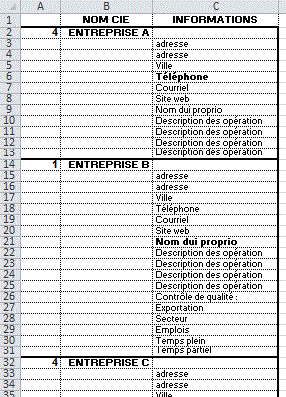
Sub TriGroupes()
Application.ScreenUpdating = False
ligneDéb = 2
NoBordure ' supprime les bordures
NbCol = 3
Columns("A:A").Offset(0, NbCol).Insert Shift:=xlToRight
i = ligneDéb
Do While i <= [A65000].End(xlUp).Row + 1
temp = Cells(i, 1)
temp2 = Cells(i, 1)
Cells(i, 1).Offset(0, NbCol) = temp2
i = i + 1
Do While Cells(i, 1) = "" And i <=
[C65000].End(xlUp).Row
Cells(i, 1).Offset(0, NbCol) = temp2
i = i + 1
Loop
Loop
Range(Cells(ligneDéb, 1), Cells([C65000].End(xlUp).Row,
NbCol + 1)).Sort Key1:=Cells(ligneDéb, 1).Offset(, NbCol),
Order1:=xlAscending, Header:=xlNo
[A:A].Offset(0, NbCol).Delete Shift:=xlToLeft
Bordures ligneDéb, NbCol
End Sub
Tri colonnes
On veut trier le tableau par lignes & colonnes.
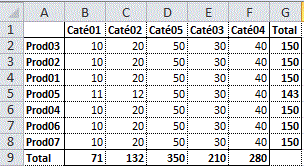
Sub TriColTbl2D()
Set Rng = Range("B1:F" & [B65000].End(xlUp).Row)
Rng.Sort key1:=Rng.Cells(1, 1), Order1:=xlAscending, Header:=xlNo,
MatchCase:=False, Orientation:=xlSortRows
End Sub
Sub TriLigTbl2D()
Set Rng = Range("A2:G" & [B65000].End(xlUp).Row
- 1)
Rng.Sort key1:=Rng.Cells(1, 1), Order1:=xlAscending, Header:=xlNo,
MatchCase:=False, Orientation:=xlSortColumns
End Sub
Tri sur la couleur de fond
Tri Couleur
Fond
Tri Couleur Fond2
Tri cadres
Tri Cadres
Tri Cadres 2
Tri Hauteur ligne
Sub Tri2()
Set debut = Range("A1") ' à adapter
n = debut.CurrentRegion.Rows.Count
nf = ActiveSheet.Name
Sheets.Add
ActiveSheet.Name = "temp"
Sheets(nf).Select
debut.CurrentRegion.Copy Sheets("temp").[A1]
nbcol = debut.CurrentRegion.Columns.Count
debut.Offset(0, nbcol).EntireColumn.Insert Shift:=xlToRight
debut.Offset(1, nbcol) = 1
debut.Offset(1, nbcol).DataSeries Rowcol:=xlColumns, Type:=xlLinear,
Date:=xlDay, _
Step:=1, Stop:=n - 1, Trend:=False
debut.Resize(n, nbcol + 1).Sort Key1:=debut.Offset(1, 0),
Order1:=xlAscending, Header:=xlGuess
For i = 1 To n - 1
x = debut.Offset(i, nbcol) + 1
Sheets("temp").Cells(x, 1).Resize(,
nbcol).Copy debut.Offset(i, 0)
Next i
debut.Offset(0, nbcol).EntireColumn.Delete
Application.DisplayAlerts = False
Sheets("temp").Delete
End Sub
Tri avec images
Il faut que les images aient la propriété Déplacer
Sub modifieMove()
For Each c In ActiveSheet.Shapes
If c.Type = 13 Then c.Placement = xlMoveAndSize
Next c
End Sub
Sub Tri()
[A1].CurrentRegion.Sort Key1:=Range("A2"),
Order1:=xlAscending, Header:=xlGuess, OrderCustom:=1, MatchCase:=False
End Sub
Tri sur double-clic sur le titre
Private Sub Worksheet_BeforeDoubleClick(ByVal Target As
Range, Cancel As Boolean)
Set titre = [A1:D1]
If Not Intersect(titre, Target) Is Nothing And Target <>
"" Then
OrdreTri = IIf(Target.Interior.ColorIndex = 3,
xlDescending, xlAscending)
Target.CurrentRegion.Sort Key1:=Cells(1, Target.Column),
Order1:=OrdreTri, Header:=xlGuess
m = IIf(Target.Interior.ColorIndex = 3, 4, 3)
titre.Interior.ColorIndex = 44
Target.Interior.ColorIndex = m
End If
Cancel = True
End Sub
Tri sur le 3e caractère dans un ordre prédéfini (GPBO)
Sub Macro1()
Set debut = [A2]
debut.Offset(, 1).EntireColumn.Insert
Set plage = debut.Resize(debut.CurrentRegion.Rows.Count -
1)
For Each c In plage
c.Offset(, 1) = Left(c, 2) & InStr("GPBO",
Mid(c, 3, 1)) & Mid(c, 4)
Next c
plage.Resize(, 2).Sort Key1:=debut.Offset(, 1), Order1:=xlAscending,
Header:=xlGuess
debut.Offset(, 1).EntireColumn.Delete
End Sub
Tri avec apostrophes
Les mots avec apostrophes sont regroupés.
Sub TriApostrophe()
[b:b].Insert
For Each c In Range([A2], [a65000].End(xlUp))
c.Offset(0, 1) = Replace(c, "'", "
")
Next c
Range("A2").CurrentRegion.Select
Selection.Sort Key1:=[B2], Header:=xlGuess
[b:b].Delete
End Sub
Tri multi-feuilles
Feuil1 , Feuil2, Feuil3 contiennent chacune 50.000 lignes
-On fusionne Feuil1+Feuil2+Feuil3
-On tri l'ensemble
-L'ensemble est découpé sur Feuil4,Feuil5,Feuil6
Tri des onglets
Tri Onglets.xls
Tri Onglet Ordre
Sub tri_ongletDirect()
Application.ScreenUpdating = False
For i = 1 To Sheets.Count
For j = i To Sheets.Count
If UCase(Sheets(j).Name) < UCase(Sheets(i).Name)
Then
Sheets(i).Move before:=Sheets(j)
Sheets(j).Move before:=Sheets(i)
End If
Next j
Next i
End Sub
Noms d' onglets numériques et alpha
Sub tri_ongletDirect2()
Application.ScreenUpdating = False
For i = 1 To Sheets.Count
For j = i To Sheets.Count
If IsNumeric(Sheets(j).Name)
Then
x = String(30 -
Len(Sheets(j).Name), "0") & Sheets(j).Name
Else
x = UCase(Sheets(j).Name)
End If
If IsNumeric(Sheets(i).Name) Then
y = String(30 - Len(Sheets(i).Name),
"0") & Sheets(i).Name
Else
y = UCase(Sheets(i).Name)
End If
If x < y Then
Sheets(i).Move before:=Sheets(j)
Sheets(j).Move before:=Sheets(i)
End If
Next j
Next i
End Sub
Tri dans une feuille temporaire
Sub trionglet2()
Sheets.Add
ActiveSheet.Name = "Tempo_jb"
For i = 1 To Sheets.Count
Cells(i, 1) = "'" &
Sheets(i).Name
Next i
Range("A1:A256").Sort Key1:=Range("A1")
For i = 1 To Sheets.Count
nonglet = Cells(i, 1)
Sheets(nonglet).Move before:=Sheets(i)
Sheets("Tempo_jb").Activate
Next i
Application.DisplayAlerts = False
Sheets("Tempo_jb").Delete
Sheets(1).Activate
End Sub
Tri dans un tableau
Sub tri_onglet()
Application.ScreenUpdating = False
Dim a(256)
n = Sheets.Count
For i = 1 To n
a(i) = Sheets(i).Name
Next i
'---- tri
For i = 1 To n
For j = i To n
If a(j) < a(i) Then
temp = a(j)
a(j) = a(i)
a(i) = temp
End If
Next j
Next i
'---
For i = 1 To n
Sheets(a(i)).Move before:=Sheets(i)
Next i
Sheets(1).Select
End Sub
Tri Quick-Sort
Le principe est le suivant:
On répartit la suite de nombres à trier de telle sorte que tous les éléments inférieurs à un élément de référence (36 sur l'exemple) soient à gauche de celui-ci et que tous ceux qui lui sont supérieurs à sa droite.
[70 61 16 48 29 18 59 36 3 70 3 22 39
30 58 10] <- Avant
¦
Elément
médian de référence
¦
[3 30 16 22 29 18] 36 [70 59 48 39 59 61 58 70] <-
Après
¦
¦
Eléments<36 Eléments>36
Tous les éléments de l'ensemble de droite sont supérieurs à ceux de l'ensemble de gauche. En procédant de la même façon sur les 2 sous-ensembles générés,on obtient 4 sous-ensembles ordonnés entre eux. Lorsque la taille des ensembles devient égale à 1,les nombres sont triés.
Choix de l'élément de référence:
Pour obtenir des sous-ensembles de tailles équilibrées,il faut que l'élément de référence ne soit ni trop petit,ni trop grand.
La méthode classique consiste à choisir l'élément
de référence parmi 3 éléments:Ceux de gauche,du
milieu et de droite.
Nous observons qu'en choisissant l'élément de référence
au milieu de la liste à traiter, le temps de tri est le même.
Remarques:
-Si la liste est déja triée,le temps de
tri n'augmente pas lorsque l'élément de référence
est choisi au milieu,ce qui n'est pas le cas lorsqu'il est choisi à
gauche.
-Le programme proposé est récursif.
Option Compare Text
Sub essai()
Dim temp(10000) As Double
For i = 1 To 10000
temp(i) = Rnd
Next i
t = Timer
Call tri(temp, 1, 10000)
MsgBox Timer - t
End Sub
Sub tri(a() As Double, gauc, droi) ' Quick sort
ref = a((gauc + droi) \ 2)
g = gauc: d = droi
Do
Do While a(g) < ref: g = g + 1:
Loop
Do While ref < a(d): d = d - 1:
Loop
If g <= d Then
temp
= a(g): a(g) = a(d): a(d) = temp
g =
g + 1: d = d - 1
End If
Loop While g <= d
If g < droi Then Call tri(a, g, droi)
If gauc < d Then Call tri(a, gauc, d)
End Sub
Tri avec caractères accentués
Sub tri(a, gauc, droi) ' Quick sort
ref = sansAccent(a((gauc + droi) \ 2))
g = gauc: d = droi
Do
Do While sansAccent(a(g)) < ref: g = g + 1:
Loop
Do While ref < sansAccent(a(d)): d = d - 1:
Loop
If g <= d Then
temp = a(g): a(g) = a(d): a(d) = temp
g = g + 1: d = d - 1
End If
Loop While g <= d
If g < droi Then Call tri(a, g, droi)
If gauc < d Then Call tri(a, gauc, d)
End Sub
Function sansAccent(chaine)
codeA = "ÉÈÊËÔéèêëàçùôûïî"
codeB = "EEEEOeeeeacuouii"
temp = chaine
For i = 1 To Len(temp)
p = InStr(codeA, Mid(temp, i, 1))
If p > 0 Then Mid(temp, i, 1) = Mid(codeB,
p, 1)
Next
sansAccent = temp
End Function
Tri matriciel
La formule matricielle est écrite une seule fois dans un champ.
-Sélectionner D2:D1000
=INDEX(champ;EQUIV(GRANDE.VALEUR(NB.SI(champ;">="&champ);LIGNE(INDIRECT("1:"&LIGNES(champ))));
NB.SI(champ;">="&champ);0))
-Valider avec Maj+ctrl+entrée
-Pour 1.000 éléments, si on modifie une cellule, temps recalcul = 1sec
Fonction liste triée
Cette fonction personalisée matricielle permet d'obtenir une liste triée . Elle est beaucoup +rapide qu'avec une formule matricielle:
-Matricielle : 1.000 éléments
--> 1sec
-VBA: 10.000
éléments --> 0,15 sec
Option Compare Text
Function ListeTriée(champ As Range)
Application.Volatile
temp = champ.Value
Dim b()
ReDim b(1 To Application.Caller.Rows.Count)
n = 0
For Each c In temp
If c <> "" Then
n = n + 1
b(n) = c
End If
Next
Call tri(b, 1, n)
ListeTriée = Application.Transpose(b)
End Function
Tri multi-zones
-Sélectionner E2:E17
=ListeTriéeMZ((A2:A6;A9:A13;A17:A21))
-Valider avec maj+ctrl+entrée
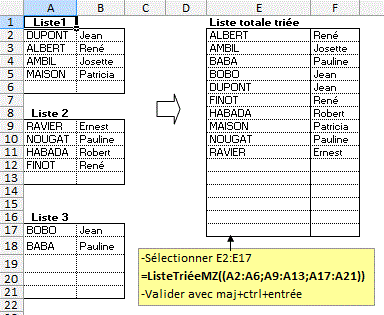
Function ListeTriéeMZ(champ As Range)
Application.Volatile
Dim b()
ReDim b(1 To Application.Caller.Rows.Count)
n = 0
For i = 1 To champ.Areas.Count ' parcours des zones du champ
multi-zones
For j = 1 To champ.Areas(i).Count ' parcours des
éléments d'une zone
If champ.Areas(i)(j) <> ""
And champ.Areas(i)(j) <> "." Then
n = n + 1
b(n) = champ.Areas(i)(j)
End If
Next j
Next i
Call Tri(b, 1, n)
ListeTriéeMZ = Application.Transpose(b)
End Function
Tri multi-feuilles
Tri multi-colonnes
Tri
Multi-colonnes
Tri Multi-colonnes
2 col
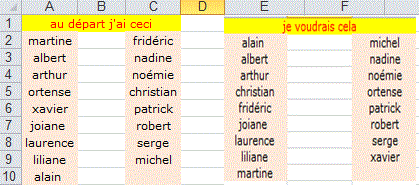
Sub TriMC()
Set Rng = Range("A2:A10,C2:C10") ' à adapter
Dim temp()
ReDim temp(Rng.Count)
lig = 0
For i = 1 To Rng.Areas.Count
For j = 1 To Rng.Areas(i).Count
If Rng.Areas(i)(j) <> ""
Then
lig = lig + 1
temp(lig) = Rng.Areas(i)(j)
End If
Next j
Next i
Call Tri(temp, 1, lig)
lig = 0
For i = 1 To Rng.Areas.Count
For j = 1 To Rng.Areas(i).Count
lig = lig + 1
Rng.Areas(i)(j) = temp(lig)
Next j
Next i
End Sub
Autre exemple
Si le champ C6:C41,I6:I41,O6:O41 a été nommé zonetri, on peut remplacer :
Set Rng1 = Range("C6:C41,I6:I41,O6:O41")
Par
Set Rng1 = Range("zonetri")
Ainsi, les champs peuvent être déplacés.
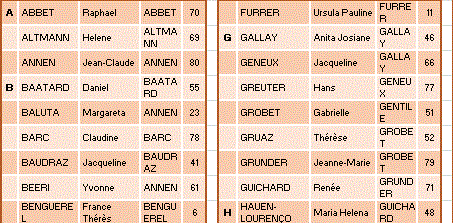
Tri multi-colonnes
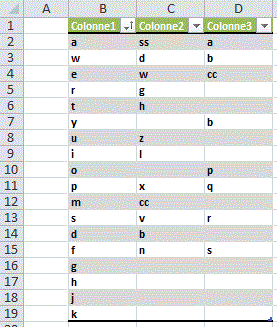
Sub Tri3Col()
Set Rng = [B2:D19]
Ht = Rng.Rows.Count
Ncol = Rng.Columns.Count
Columns(Rng.Column).Insert Shift:=xlToRight
For c = 1 To Ncol
Cells(Rng.Row + (c - 1) * Ht, Rng.Column
- 1).Resize(Ht).Value = Rng.Columns(c).Value
Next c
Rng(1, 1).Offset(, -1).Resize(Ht * Ncol).Sort key1:=Rng.Offset(,
-1), Header:=xlNo
For c = 1 To Ncol
Rng.Columns(c).Value = Cells(Rng.Row + (c
- 1) * Ht, Rng.Column - 1).Resize(Ht).Value
Next c
Columns(Rng.Column - 1).Delete
End Sub
Tri négatifs/positifs puis Alpha
Tri les nombres négatifs puis positifs puis dans l'ordre alphabétique à l'intérieur de chaque groupe.
Tri Négatifs Positifs puis Alpha
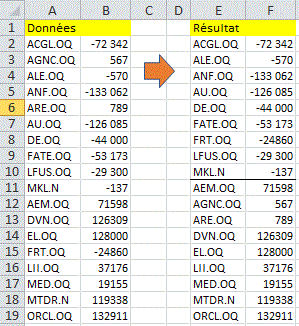
Sub TriNegPosAlpha()
Range("c2:c" & [A65000].End(xlUp).Row).FormulaR1C1
= "=RC[-1]>0"
Range("a2:c" & [A65000].End(xlUp).Row).Sort
key1:=[C3], key2:=[A3], Header:=xlNo
Cells(Application.Match(True, [C:C], 0), 1).Resize(, 2).Borders(xlEdgeTop).Weight
= xlThin
Range("c2:c" & [A65000].End(xlUp).Row).ClearContents
End Sub
Tri sans doublons
Sub classement()
Set Rng = Range("d2:E" & [D65000].End(xlUp).Row)
tbl = Rng.Value
Set d = CreateObject("scripting.dictionary")
For i = 1 To UBound(tbl)
d(tbl(i, 1)) = tbl(i, 2)
Next i
[G2].Resize(d.Count) = Application.Transpose(d.keys)
[H2].Resize(d.Count) = Application.Transpose(d.items)
[G2].CurrentRegion.Sort key1:=[H2], Order1:=xlDescending,
Header:=xlNo
End Sub
Tri de plusieurs blocs
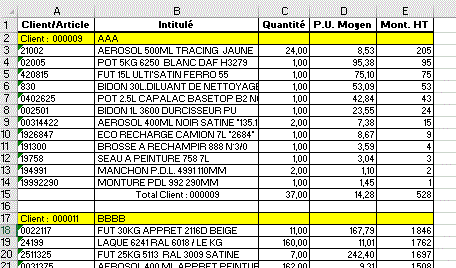
Option Compare Text
Sub Tri()
début = 1
Fin = 65000
Do
Set result1 = Range(Cells(début, "A"),
Cells(Fin, "A")).Find(what:="client")
If Not result1 Is Nothing Then
Set result2 = Range(Cells(début,
"B"), Cells(Fin, "B")).Find(what:="total client")
If Not result2 Is Nothing Then
Set Rng =
Range(result1.Offset(1), result2.Offset(-1, 3))
Rng.Sort Key1:=result1.Offset(1,
4), Order1:=xlDescending, Header:=xlNo
End If
End If
début = result2.Row + 1
Loop Until result1 Is Nothing
End Sub
Fonction Filtre(champ_données;champ_critère;critère) (Excel 2019)
=FILTRE(Tableau1;Tableau1[Ville]=E2)

Fonction Tri(champ_données;colonneTri) (Excel 2019)

On peut combiner Filtre() et Tri()
=TRI(FILTRE(Tableau2;Tableau2[Ville]=D2))
Fonction Unique(champ_colonne) (Excel 2019)
=TRI(UNIQUE(A2:A16))

Fonctions personalisées
Fonction
tri 1 colonne
Fonction tri une BD
Fonction Filtre une
BD avec 2 critères